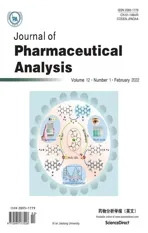Anti-inflammatory and analgesic properties of Moroccan medicinal plants:Phytochemistry,in vitro and in vivo investigations,mechanism insights,clinical evidences and perspectives
2022-04-07AlhkimBouyhyFtimEzzhrGuouguouNsrinElOmriNoulElMnyiyAlliBlhiMohmElShzlyYoussfBkri
Alhkim Bouyhy,Ftim-Ezzhr Guouguou,Nsrin El Omri,Noul El Mnyiy,Alli Blhi,Mohm El-Shzly,Youssf Bkri
aLaboratory of Human Pathologies Biology,Department of Biology,Faculty of Sciences,and Genomic Center of Human Pathologies,Faculty of Medicine and Pharmacy,Mohammed V University in Rabat,4014,Morocco
bMohammed V University in Rabat,LPCMIO,Materials Science Center(MSC),Ecole Normale Sup′erieure,Rabat,1014,Morocco
cLaboratory of Histology,Embryology and Cytogenetic,Faculty of Medicine and Pharmacy,Mohammed V University in Rabat,10100,Morocco
dDepartment of Biology,Faculty of Sciences Dhar El Mahraz,University Sidi Mohamed Ben Abdellah,Fez,30003,Morocco
eLaboratory of Zoology and General Biology,Faculty of Sciences,Mohammed V University in Rabat,Rabat,1014,Morocco
fDepartment of Pharmacognosy,Faculty of Pharmacy,Ain-Shams University,Cairo,11566,Egypt
gDepartment of Pharmaceutical Biology,Faculty of Pharmacy and Biotechnology,German University in Cairo,Cairo,11835,Egypt
Keywords:
Inflammation
Medicinal plants
Bioactive compounds
Anti-inflammatory
Analgesic
A B S T R A C T
Moroccan medicinal plants exhibit several pharmacological properties such as antimicrobial,anticancer,antidiabetic,analgesic,and anti-inflammatory effects,which are related to the presence of numerous bioactive compounds,including phenolic acids,flavonoids,and terpenoids.In the present review,we systematically evaluate previously published reports on the anti-inflammatory and analgesic effects of Moroccan medicinal plants.The in vitro investigations revealed that Moroccan medicinal plants inhibit several enzymes related to inflammatory processes,whereas in vivo studies noted significant antiinflammatory and analgesic effects as demonstrated using different experimental models.Various bioactive compounds exhibiting in vitro and in vivo anti-inflammatory and analgesic effects,with diverse mechanisms of action,have been identified.Some plants and their bioactive compounds reveal specific secondary metabolites that possess important anti-inflammatory effects in clinical investigations.Our review proposes the potential applications of Moroccan medicinal plants as sources of anti-inflammatory and analgesic agents.
1.Introduction
Inflammation is a physiological process that involves the intervention of the immune system.The key role of inflammation is to protect organisms against microbial infections,and in some instances,it acts as a physiological defense mechanism against certain diseases such as cancer[1].However,under certain circumstances,inflammation can become harmful,leading to serious pathological conditions.The prolonged overexpression of inflammatory factors can alter several physiological processes by activating numerous signaling pathways,especially the transcriptional factor nuclear factor kappa B(NF-κB),which regulates the expression of multiple inflammatory genes that induce the inflammatory process[2].Cellular inflammation can be the driving factor for several diseases,leading to cell death and organ damage,or cellular stimulation,thus initiating tumor formation.Chronic inflammation is considered as an integral part of developing various diseases,including diabetes,heart diseases,cancer,digestive disorders,autoimmune diseases, or neurodegenerative disorders[3,4].Accordingly,the suppression of inflammation is an attractive therapeutic strategy to fight inflammation-related diseases.However,drugs targeting inflammation,such as nonsteroidal anti-inflammatory drugs(NSAIDs),demonstrate serious side effects on human health [5]. To meet the need for efficacious antiinflammatory drugs that can overcome the debilitating side effects of currently available medications,scientists have directed their efforts toward identifying safe and effective antiinflammatory agents from herbal medicines.
Over the past decade,several studies have focused on identifying natural bioactive compounds with anti-inflammatory and analgesic effects.Secondary metabolites of medicinal plants,including polyphenols,flavonoids,terpenoids,and alkaloids,are essential sources for developing anti-inflammatory and analgesic drugs[6-8].Recent reports have revealed that these molecules exhibit an anti-inflammatory effect by suppressing inflammatory mediators involved in inflammatory processes,including cytokines,chemokines,and pro-and neo-inflammatory mediators[9].
Notably,there exist numerous examples of successful drug development from medicinal plants.Morphine was discovered from natural sources and remains one of the most potent analgesic drugs for pain management.Morphine was isolated from poppy latex(Papaver somniferum),more commonly known as opium,and possesses sedative and analgesic properties[10].Typically,analgesics can be categorized as morphine and non-morphine analgesics.Morphine and its derivatives are selective,are commonly known as opiates,and demonstrate various psychotropic properties,including a central depressant effect.Non-morphine derivatives present analgesic and antipyretic or anti-inflammatory activities and are prescribed for low-intensity pain.Morphine analgesia suppresses painful sensations through specific signaling pathways and is used for treating chronic pain,hyperalgesia,hepatic and renal colic,myocardial infarction,acute lung edema,and postoperative pain[11].However,these analgesics present several side effects,including addiction,nausea,constipation,and respiratory depression.In an attempt to overcome some side effects associated with morphine,numerous semisynthetic derivatives have been developed,including codethyline,pholcodine,and diamorphine,as well as synthetic products such as pethidine,phenoperidine,and buprenorphine[12].
In Morocco,medicinal plants have been used since antiquity to treat illnesses such as diabetes,microbial infections,cancer,and inflammation[13].Studies have reported that products extracted from these medicinal plants exhibit important pharmacological properties such as antibacterial,anticancer,antidiabetic,and antiinflammatory effects and can be potentially developed into new drugs targeting human and animal diseases.In the present review,the in vitro and in vivo anti-inflammatory and analgesic reports on Moroccan medicinal plants are summarized and critically analyzed to provide a clear perspective on their potential applications in developing novel drugs with potent activity and improved safety profiles.
2.Anti-inflammatory activities
2.1.In vitro anti-inflammatory effects
Lipoxygenase(LOX)is an enzyme that catalyzes the addition of molecular oxygen to fatty acids containing a cis,cis-1,4-pentadiene system originating from unsaturated fatty acid hydroperoxides[14].The products possess an oxidant-promoting effect,and therefore,anti-LOXs are deemed as antioxidants.LOX products can also be converted to other derivatives that play crucial roles in inflammatory processes.Thus,the suppression of LOX activity can reduce inflammatory symptoms.Cyclooxygenase(COX)catalyzes the degradation of eicosatrienoic acid(arachidonic acid)into several leukotrienes[14].Researchers have attempted to develop novel and more efficient anti-inflammatory drugs by inhibiting COX activity.Some Moroccan medicinal plants reportedly possess the ability to significantly inhibit LOX.Table S1[15,16]summarizes the findings of studies assessing the inhibitory effects of Moroccan medicinal plants on LOX.
Miguel et al.[15]evaluated the anti-LOX effect of hydro-alcoholic extracts of Haloxylon scoparium,Corrigiola telephiifolia,Ammodaucus leucotrichus,Chamaerops humilis,Sideritis arborescens,Ammi visnaga,Vitex agnus castus,Retama raetam,Berberis vulgaris,Viscum album,and Equisetum arvense.The results revealed that all tested species exhibited anti-LOX activity with some variability.Extracts of V.album,B.vulgaris,and A.visnaga demonstrated the most potent LOX inhibitory activity,with IC50values of 0.236±0.030,0.266±0.030,and 0.262±0.030 mg/mL,respectively.Despite the high activity,these effects were significantly inferior to the inhibitory effect demonstrated by the positive control(nordihydroguaiaretic acid;IC50value of 0.020±0.030 mg/mL)[15].The authors revealed that the inhibition of LOX by plant extracts was positively correlated with their antioxidant activities[15,16].
In another study,Aazza et al.[16]evaluated the LOX inhibitory effect of Thymus vulgaris,Citrus limon,Citrus aurantium,Eucalyptus globulus,Cupressus sempervirens,and Foeniculum vulgare essential oils.They reported that the essential oils extracted from F.vulgare presented the most potent inhibitory effect at the lowest concentration value(IC50=0.04±0.01 mg/mL).The essential oils of E.globulus(IC50=0.16±0.07mg/mL),C.sempervirens(IC50=0.17±0.07 mg/mL),and T.vulgaris(IC50=0.19±0.00 mg/mL)showed unexpected anti-LOX activities[16].
2.2.In vivo anti-inflammatory effects
The inhibition and/or the suppression of inflammation is one of the most important strategies to treat several complicated pathologies such as cancer,diabetes,and atherosclerosis.Several bioactive compounds have been utilized to specifically target inflammatory mediators and signaling pathways leading to this process.However,these anti-inflammatory drugs are accompanied by serious side effects,especially hepatotoxicity.Numerous studies have evaluated the anti-inflammatory activity of secondary metabolites from terrestrial plants.In Morocco,several research groups examined the in vivo anti-inflammatory activity of extracts derived from endogenous medicinal plants and their isolates(Table 1)[17-31].As listed in Table 1,Moroccan medicinal plants such as Meiocarpidium lepidotum,Asphodelus aestivus,Calendula arvensis,Cistus salviifolius,Cistus monspeliensis,Tetraclinis articulata,Ceratonia siliqua,Pelargonium graveolens,Marrubium vulgare,Melissa officinalis, Syzygium aromaticum, Papaver rhoeas,Delphinium staphysagria,Ziziphus lotus,Argania spinosa,and Zygophyllum gaetulum have been investigated.These plants belong to several plant families,including Annonaceae,Asphodelaceae,Asteraceae,Cistaceae,Cupressaceae,Fabaceae,Geraniaceae,Lamiaceae,Myrtaceae,Papaveraceae,Ranunculaceae,Rhamnaceae,Sapotaceae,and Zygophyllaceae.
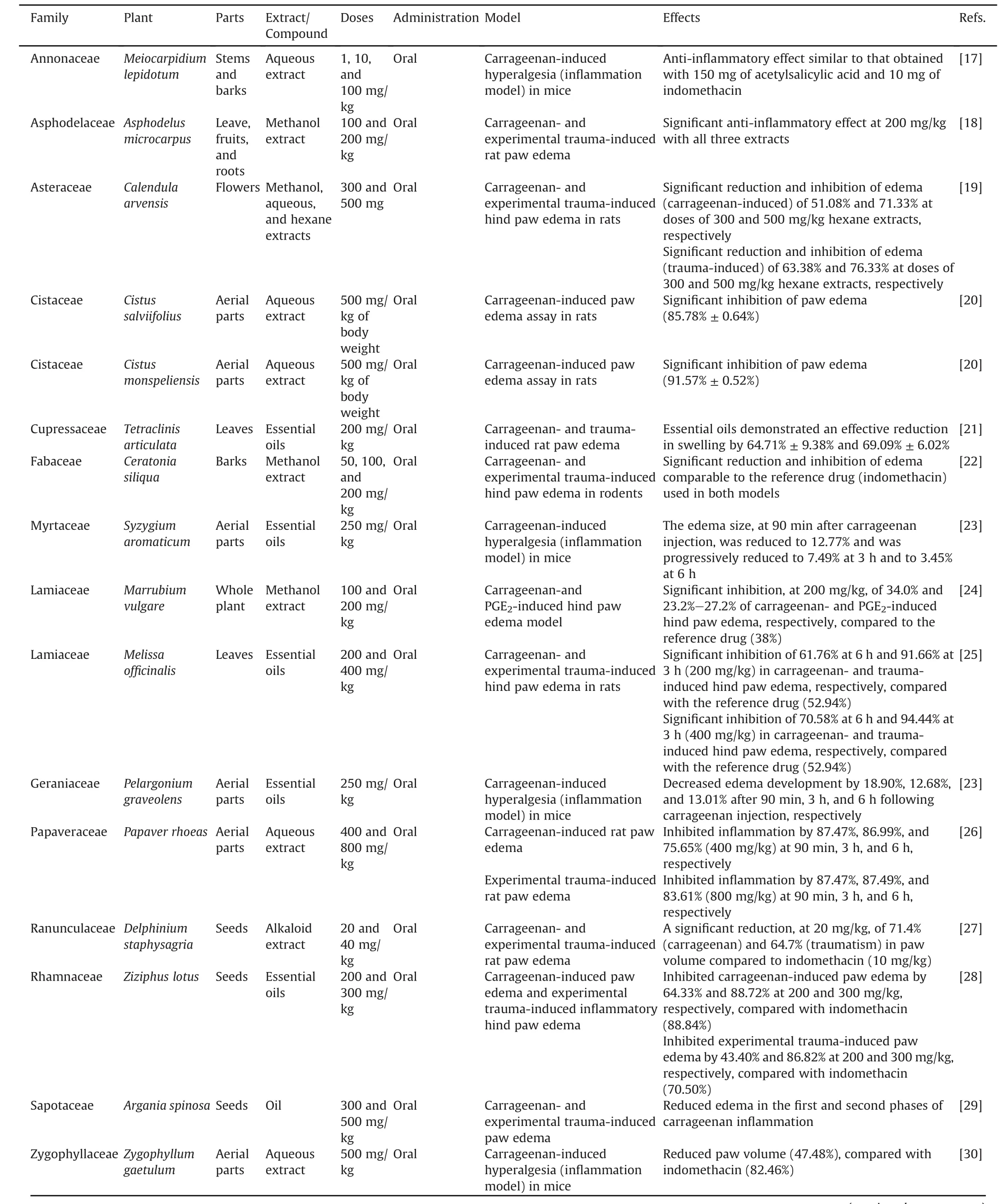
Table 1In vivo anti-inflammatory activity of Moroccan medicinal plants.

Table 1(continued)
2.2.1.In vivo anti-inflammatory activity of extracts
Moroccan medicinal plant extracts are rich in secondary metabolites such as phenolic acids,flavonoids,and alkaloids.These compounds are well-known for their anti-inflammatory effect.Previous literature has revealed that Moroccan medicinal plant extracts possess a potent anti-inflammatory effect,confirmed in several in vivo assays(Table 1).Meddah et al.[17]evaluated the anti-inflammatory effect of M.lepidotum(Annonaceae),a medicinal plant used in Moroccan traditional medicine to treat several illnesses[17].The in vivo anti-inflammatory effect of M.lepidotum crude aqueous extract was evaluated at 1,10,and 100 mg/kg doses using carrageenan-induced hyperalgesia by injecting 50 μL of λcarrageenan(2.5%)suspended in saline(0.9%)into the plantar surface of the right mouse hind paw.The paw volume was measured 1,2,3,and 4 h after injection using an LE 7500 plethysmometer.The results showed that M.lepidotum extract significantly reduced the swelling of edematous paws.The antiinflammatory effect was similar to the effects demonstrated by acetylsalicylic acid(150 mg)and indomethacin(10 mg).The authors attributed the observed anti-inflammatory effect to the presence of triterpenes as the major class of compounds in the M.lepidotum crude aqueous extract[17].
In another study,Hosni et al.[18]investigated the antiinflammatory effect of the leaves,fruits,and roots of Asphodelus microcarpus(Asphodelaceae)methanolic extracts.In this study,the extracts were orally administered at 100 and 200 mg/kg,and carrageenan-induced rat paw edema was established by subcutaneously injecting 0.05 mL of 1% carrageenan in NaCl(9%)into the subplate area of the left rat paw.The experimental trauma-induced rat paw edema was assayed by dropping a 50 g weight on the left rat paw.Then,the volume of both paws was measured using a plethysmometer after 90 min,3 h,and 6 h.The results revealed that A.microcarpus extracts possessed a significant anti-inflammatory effect at 200 mg/kg.The leaf extract showed potent inhibition(80.77%)when compared with indomethacin,which was employed as the positive control(79.41%).The toxicological investigation revealed that this plant was non-toxic at the specified doses.
By employing identical methods(carrageenan-and experimental trauma-induced hind paw edema),Abudunia et al.[19]evaluated the anti-inflammatory effect of C.arvensis methanol,aqueous,and hexane extracts.This study revealed that C.arvensis extracts exhibited potent anti-inflammatory activity.The hexane extract showed potent effects at doses of 300 and 500 mg/kg.Three hours after edema induction,the extract(300 mg/kg)reduced carrageenan-induced edema by 51.08% and experimental traumainduced rat paw edema by 71.33%;at 500 mg/kg,the reduction was 63.38% and 76.33%,respectively,in both assays.These results were similar to those of indomethacin,the standard drug,which showed a 72.36% reduction in edema[19].
C.salviifolius(L.)and C.monspeliensis(L.),two medicinal plants belonging to the Lamiaceae family,are used in Moroccan folk medicine to treat several illnesses,especially inflammatory-related diseases.To validate their anti-inflammatory effect,Sayah et al.[20]evaluated the in vivo anti-inflammatory effect of aqueous extracts of these two plants(aerial parts)using the carrageenan-induced paw edema assay in rats.The results revealed that aqueous extracts of C.salviifolius and C.monspeliensis significantly inhibited paw edema at 500 mg/kg,resulting in inhibition values of 85.78%±0.64% and 91.57%±0.52%,respectively,when compared with the reference drug indomethacin(10 mg/kg),which presented an inhibition value of 62.75%±1.21%[20].
The methanolic bark extract of C.siliqua L.,a medicinal plant used in Morocco as an antidiarrheal and diuretic,was evaluated for its antiinflammatory effect. The effect of this extract(50,100,and200mg/kg peroral(p.o.))was assessed in female Swiss mice(20-30g)and male Wistar rats(150-250 g)by inducing edema of the hind paw using carrageenan and physical trauma[22].The findings revealed that the C.siliqua methanolic bark extract exhibited a maximal reduction(0.20±0.01)and inhibition(68.70%)of edema at 200mg/kg,similar to that of indomethacin(0.19±0.01 and 71%),in carrageenan-induced rat paw edema.In the experimental trauma-induced paw edema model,the extract inhibited edema formation by 70%,with a reduction of 0.20±0.01,similar to indomethacin,which presented 74.3% inhibition and 0.18±0.0 reduction in edema[22].A toxicological investigation demonstrated that C.siliqua extracts did not induce mortality or alter animal behavior[22].
The anti-inflammatory activity of M.vulgare methanolic extract was evaluated by employing carrageenan-and prostaglandin E2(PGE2)-induced hind paw edema models[24].The results revealed that this extract demonstrated significant inhibition(34.0%)at 200 mg/kg in the carrageenan-induced hind paw edema test.Interestingly,the extract(200 mg/kg)showed considerable inhibition(23.2%-27.2%)in PGE2-induced hind paw edema when compared with the reference drug(indomethacin),which showed 38% inhibition after 45 min.However,the inhibitory activity of the M.vulgare extract was significantly lower than that of C.siliqua extracts[24].
P.rhoeas L.(Papaveraceae)flowers are used to treat mild earache,toothache,and neuralgia.Hajjaj et al.[26]evaluated the anti-inflammatory effect of an aqueous extract of P.rhoeas(400 and 800 mg/kg p.o.)by inducing hid-paw edema using carrageenan and physical trauma.The P.rhoeas aqueous extract(400 mg/kg)exhibited inhibition of 87.47%,86.99%,and 75.65% at 90 min,3 h,and 6 h,respectively,in carrageenan-induced hind paw edema.However,at 800 mg/kg,the aqueous extract showed inhibition of 87.47%,87.49%,and 83.61%,respectively,in experimental traumainduced rat paw edema.This plant exhibited no toxicity at investigated doses(LD50=2000 mg/kg)[26].
Faridi et al.[27]evaluated the anti-inflammatory effect of D.staphysagria seed extracts,reportedly rich in alkaloids,by employing carrageenan-induced rat paw edema and an experimental trauma model by dropping a 50 g weight on the rat paw.The authors revealed that oral administration of D.staphysagria alkaloid extracts(20 mg/kg)significantly reduced paw volume by 71.4%(carrageenan)and 64.7%(traumatism)when compared with indomethacin as the drug control[27].
Z.gaetulum Emberger.&Maire.is a medicinal plant used in Moroccan traditional medicine to combat inflammation,diabetes,spasms,and diarrhea.Experimental studies have revealed the antiinflammatory effect of this species[28].
Animals treated with an aqueous extract of Z.gaetulum demonstrated a significant inhibition in edema in all phases of the experiment,with inhibitions of 47.40%,33.94%,and 11.04% at 90 min,3 h,and 6h,respectively,compared with the reference drug(indomethacin)presenting inhibitions of 82.46%,31.67%,and 18.24%,respectively [31].The anti-inflammatory effect of Z.gaetulum ethanolic and aqueous extracts was evaluated by Ait El Cadi et al.[30]by employing carrageenan-induced hyperalgesia in mice.Oral administration of these extracts at 500 mg/kg potently inhibited edema in the last phase of the experimental model.The paw volume significantly reduced following treatment with the ethanolic and aqueous extracts,presenting inhibitions of 46% and 47.48%,respectively,compared with indomethacin(positive control),which showed 82.46% inhibition[30].
2.2.2.In vivo anti-inflammatory activity of the volatile compounds
Essential oils are known to contain several compounds such as monoterpenes,sesquiterpenes,and other components that demonstrate numerous beneficial biological effects.Studies have reported various essential oils isolated from Moroccan medicinal plants such as T. articulata, P. graveolens,M.officinalis,S.aromaticum,Z.lotus,and Z.gaetulum,which were investigated for their anti-inflammatory properties,as presented in Table 1.
T.articulata(known as Al'Araar)is a Moroccan medicinal plant used for treating diarrhea,gastric pain,and diabetes.In a recent study,El Jemli et al.[21]investigated the anti-inflammatory effect of the essential oil from T.articulata leaves(200 mg/kg)by inducing rat paw edema via carrageenan and physical trauma.The authors revealed that essential oils derived from T.articulata significantly reduced swelling by 64.71%±9.38% and 69.09%±6.02% in the chemical and mechanical methods,respectively,when compared with the effect of indomethacin as a reference drug,presenting inhibitions of 62.37% and 75.45%,respectively.These results were attributed to the presence of bornyl acetate(26.81%),camphor(22.40%),and α-pinene(7.16%)as major bioactive compounds of T.articulata essential oil.In addition,no mortality was observed on investigating the acute toxicity of this essential oil(LD50=5000 g/kg).
M.officinalis is another medicinal plant belonging to the Lamiaceae family.In Morocco,this plant is used as a calming,antispasmodic,and muscle-strengthening agent.Essential oils from the leaves of this plant were evaluated for their anti-inflammatory properties using carrageenan-and experimental trauma-induced hind paw edema in rats[25].The results revealed that M.officinalis essential oils,administered at 200 and 400 mg/kg p.o.,showed a significant reduction and inhibition of edema by 70.58% and76.47%,respectively,at 90 min,and by 61.76% and 70.58% at 6 h,in carrageenan-induced hind paw edema.The results were comparable with the positive control(indomethacin),which demonstrated 76.47% and 52.94% inhibition after 1 h and 3 h,respectively.In the experimental trauma model,M.officinalis essential oil at 200 and 400 mg/kg p.o.exhibited maximum anti-inflammatory activity,with91.66% and94.44% edema inhibition after 3h,respectively.After 6h,the inhibition was similar to that observed with indomethacin(10 mg/kg,p.o.),revealing an inhibition of 91.66%.This effect could be attributed to the presence of nerol,citral,isopulegol,caryophyllene,caryophyllene oxide,and citronella as major compounds of M.officinalis essential oil[25].
Marmouzi et al.[23]reported the anti-inflammatory effect of essential oils of P.graveolens(Geraniaceae)and S.aromaticum(Myrtaceae)aerial parts by employing the carrageenan model at 250 mg/kg.For S.aromaticum,the edema size of the group treated with essential oil was reduced to 12.77%,90 min after the carrageenan injection.This value was reduced to 7.49% and 3.45% after 3 h and 6 h,respectively.Regarding P.graveolens essential oil,edema development 90 min after carrageenan injection was progressively reduced to 12.68% at 3 h and 13.01% at 6 h.The combination of both essential oils showed a considerable antiinflammatory activity,with an inhibition of 86.17%,87.79%,and 84.84% produced at 90 min,3 h,and 6 h,respectively.The results were comparable with the reduction produced by 10 mg/kg and 20 mg/kg of indomethacin at 90 min,3 h,and 6 h,which presented inflammation inhibition values ranging 71.17%-86.89%,78.59%-83.94%,and67.63%-75.63%,respectively[23].The chemical analysis of these essential oils revealed the presence of eugenol(74.06%),caryophyllene(11.52%),and carvacrol acetate(7.82%)as major compounds of S.aromaticum.Citronellol(30.77%),10-epi-γeudesmol(22.59%),and geraniol(13.95%)were the major compounds identified in P.graveolens[23].
In Morroco,Z.lotus is a medicinal plant used as an antiinflammatory,antidiabetic,and antimicrobial agent.El Hachimi et al.[28]examined the anti-inflammatory effect of Z.lotus seed essential oil using carrageenan-induced paw edema and traumainduced inflammatory hind paw edema.Like indomethacin(used as the reference drug),Z.lotus essential oil exhibited potent antiinflammatory activity.At a dose of 300 mg/kg p.o.,this oil exhibited a potent dose-dependent effect,revealing a better inhibitory effect than that of indomethacin[28].The authors suggested that this plant could be considered as a promising source of antiinflammatory agents as it showed no toxicity in animal models.
3.Analgesic activity
Medicinal plants have been used since ancient times as analgesic agents.As synthetic drugs are expensive and have several side effects,plants are considered alternative sources for screening analgesic drugs.Medicinal plants are known to induce a biological balance owing to their natural active ingredients,synergistic effects of active ingredients,and low levels of accumulation in the body.Drugs and their side effects are among the main reasons why pharmaceutical companies and the public adopt herbal medicines to treat certain diseases.Plants and their products can be used in some instances as ideal substitutes for synthetic drugs[32].Research on plants with medicinal properties,including analgesic activities,is necessary and can serve as a basis for treating various disorders and complications[33].Flavonoids,alkaloids,and several other chemical classes have provenuseful as analgesic agents.Flavonoids are among the most abundant chemical classes of medicinal plants and have revealed important analgesic activities.Indeed,flavonoids reportedly prevent prostaglandins from inducing COX in inflamed tissues[32].Apigenin is known to reduce the flow of lipids needed to signal pain.Therefore,flavonoids reduce inflammatory pain by inhibiting receptors and signaling cascades[32].
The analgesic activity of Moroccan medicinal plants was investigated by several research groups [12,17,18,20,24,34-38].Numerous medicinal plants have been assessed,including M.vulgare,M.lepidotum,Nepeta amethystina,C.monspeliensis,C.salviifolius,Cotula cinerea,P.rhoeas,A.microcarpus,Chenopodium ambrosioides,Nepeta atlantica,Nepeta tuberosa,and Thymus broussonetii,belonging to six botanical families,including Labiaceae,Papaveraceae,Asteraceae,Cistaceae,Lamiaceae,and Annonaceae(Table 2)[12,17,20,24,26,34-39].
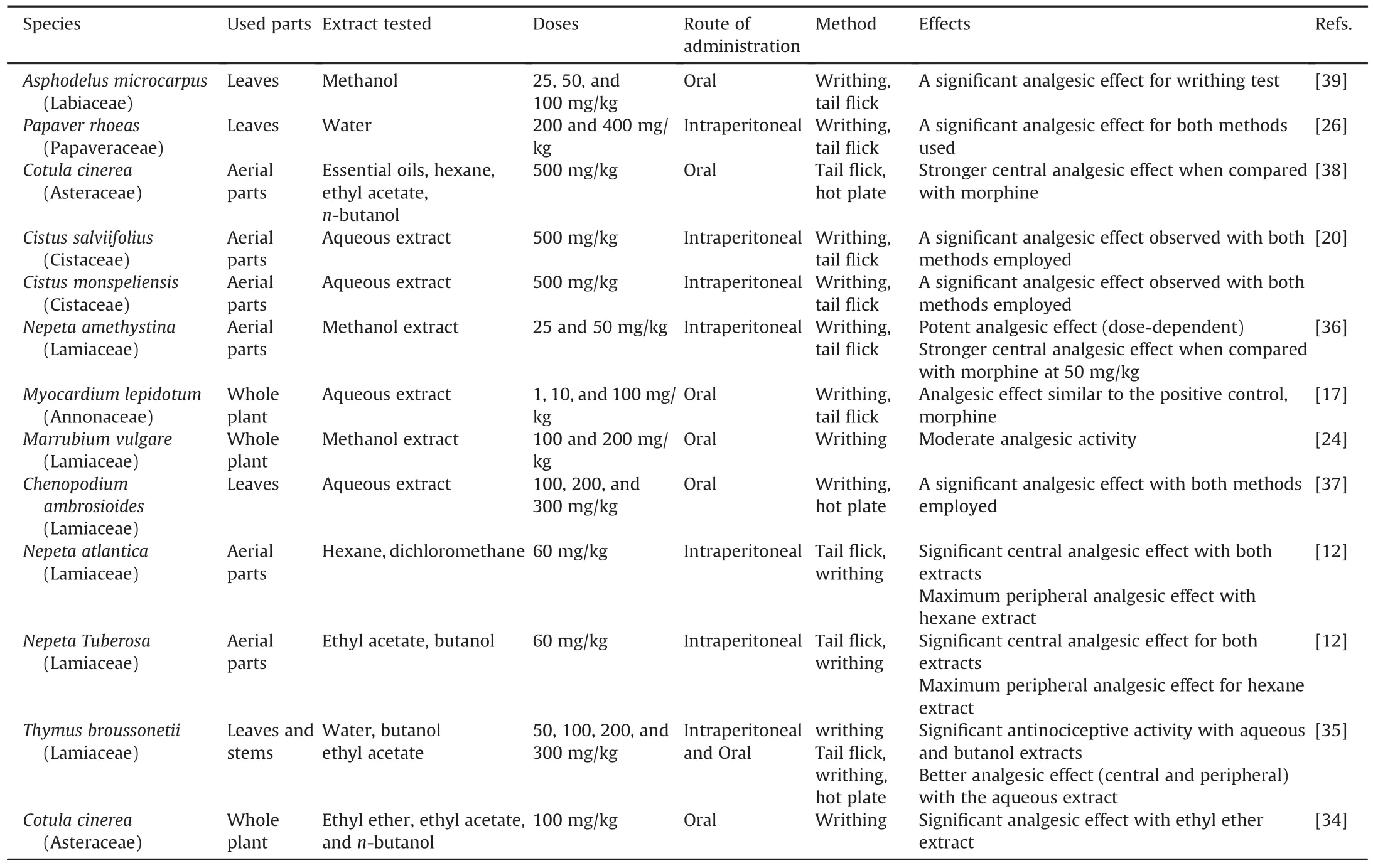
Table 2Moroccan plant extracts investigated for their analgesic activity.
Among medicinal plants evaluated from the Lamiaceae family,Belabda et al.[36]assessed the analgesic effect of the methanol extract of N.amethystina aerial parts using abdominal writhing and tail-flick tests following intraperitoneal(i.p.)administration of 25 and 50 mg/kg doses.Accordingly,the extract showed significant peripheral and central analgesic effects.The peripheral analgesic effect was higher than that demonstrated by acetylsalicylic acid,which was used as a standard drug at 200 mg/kg i.p.Additionally,the central analgesic activity of N.amethystina was significantly comparable with that of morphine(50 mg/kg i.p.)[36].M.vulgare,another medicinal species in the Lamiaceae family,is traditionally used as an anti-inflammatory and analgesic agent.The analgesic effect of this herb was evaluated using the abdominal writhing test[24].Accordingly,the methanol extract of the aerial parts,administered orally at 100 and 200 mg/kg,exhibited moderate peripheral analgesic activity[24].
In another report,Bouidida et al.[12]investigated the analgesic effect of N.atlantica and N.Tuberosa(two medicinal species of Lamiaceae).For N.atlantica,the authors used hexane and dichloromethane extracts,while ethyl acetate and butanol extracts of N.Tuberosa were employed.The analgesic activity was investigated by i.p.administration of each extract at 60 mg/kg using the tail-flick and writhing tests.Both dichloromethane and ethyl acetate extracts demonstrated significant central analgesic effects.The results revealed that extracts of both medicinal plants showed important analgesic activity,with few differences.The hexane extract of N.atlantica exhibited the most potent peripheral analgesic effect.
The aqueous extract of C.ambrosioides leaves(Lamiaceae)was evaluated for its analgesic activity by Hallal et al.[37]by employing writhing and hot plate tests.After oral administration of 100,200,and 300 mg/kg,this extract exhibited a potent analgesic effect in both models.Using models such as formalin injection,tail-flick test,abdominal writhing,and hot plate test,Elhabazi et al.[35]evaluated the analgesic effect of T.broussonetii water,butanol,and ethyl acetate extracts at 50,100,200,and 300 mg/kg.Following oral and i.p.administration,the results revealed that butanol and aqueous extracts exhibited antinociceptive activity.This effect was observed at both central and peripheral levels.
C.cinerea(Asteraceae)is a medicinal plant used in Morocco to treat several illnesses,including inflammation.In 1999,Markouk et al.[34]investigated the analgesic effect of ethyl ether,ethyl acetate,and n-butanol whole plant extracts using the writhing test.The administration(p.o.)of these three extracts at 100 mg/kg revealed that only the ethyl ether extract exhibited significant analgesic activity.The essential oil,hexane,ethyl acetate,and nbutanol aerial part extracts of the same plant were recently assessed for their central and peripheral analgesic effects using the tail-flick and hot plate tests[38].The results revealed that the extracts exhibited potent analgesic activity,especially on the central nervous system,which was significantly comparable with that of morphine(used as the standard drug).Sayah et al.[20]evaluated the analgesic activity of aqueous extracts derived from the aerial parts of two species of genus Cistus (C.salviifolius and C.monspeliensis)using writhing and tail-flick tests,at 500 mg/kg i.p.Both plants showed a significant analgesic effect,especially on the peripheral nervous system[20].
4.Toxicological studies
Several plant species are still not the subject of intense scientific research despite their enormous potential as a source of natural substances with potential therapeutic effects.However,some of their components have been identified as being potentially toxic,mutagenic,carcinogenic,and teratogenic[40].Typically,people tend to believe that the use of plants is safe and devoid of side effects,as they are of natural origin when compared with synthetic substances[41].However,medicinal plants can be toxic and cause adverse effects or even poisoning[42].Herbal preparations can become toxic when one of its constituents,which may possess serious toxic effects,remains unidentified or inaccurately identified.Several reports have recorded severe toxicities associated with the use of plant species[40-42].This observation raises concerns in terms of the potential toxic effects resulting from the short-or long-term use of these plants.Therefore,it is essential to conduct in-depth scientific investigations on the toxicity and risks of plants prior to any pharmacological and preclinical studies,as it allows better use of these plants while avoiding negative effects on the population's health.Toxicological studies on Moroccan medicinal plants evaluated for their anti-inflammatory and analgesic effects are presented in Table S2[17,18,21,22,26-28,34,36,38].The reports of Faridi et al.[27]on D.staphysagria,Lachkar et al.[22]on C.siliqua,and Hajjaj et al.[26]on P.rhoeas have suggested that these plants do not possess any toxic effects,are well tolerated,and exhibit a potent anti-inflammatory effect.In other reports,the evaluation of the in vivo analgesic activities of T.broussonetii and C.ambrosioides by Elhabazi et al.[35]and Hallal et al.[37],respectively,revealed that these two plants are non-toxic and pose no risk to treated animals.
5.Bioactive compounds of Moroccan medicinal plants with anti-inflammatory and analgesic properties
Medicinal plants contain bioactive molecules that are known as secondary metabolites.These metabolites include phenolic acids,flavonoids,alkaloids,and terpenes.The aqueous,butanol,and ethyl acetate extracts from the leaves and stems of T.broussonetii contain several bioactive compounds,including flavonoids,tannins,quinones,saponins,and terpenes[35],with identical chemical classes detected in C.ambrosioides leaf extracts[37].Organic extracts of these medicinal plants are rich in phenolic compounds such as tannins, quinones, and sterols [22]. Table S3[16,17,21-23,25-27,29,35,37,38]summarizes the identified bioactive compounds and their chemical classes.The identified phenolic acids in Moroccan medicinal plants,with anti-inflammatory and analgesic properties,were gallic,vanillic,syringic,p-coumaric,caffeic,ferulic,sinapic,and p-hydroxybenzoic acids(Fig.1).Additionally,Kamal et al.[29]identified these compounds in the vegetable oil of A.spinosa.Flavonoids such as epicatechin and quercetin have shown analgesic and anti-inflammatory activities and were identified in A.spinosa vegetable oil(Fig.2)[29].
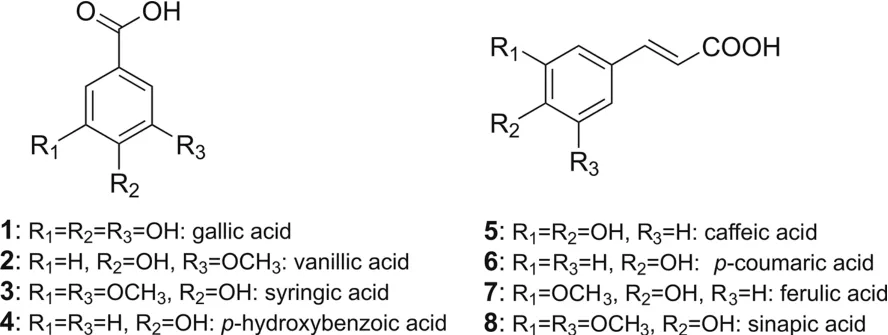
Fig.1.Structures of phenolic acids identified in Moroccan medicinal plants possessing anti-inflammatory and analgesic properties.
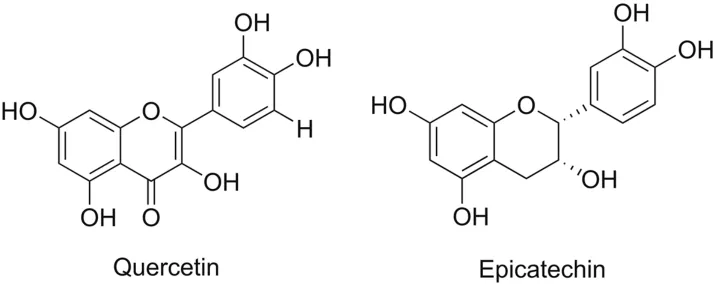
Fig.2.Structures of flavonoids identified in Moroccan medicinal plants possessing anti-inflammatory and analgesic activities.
Moroccan medicinal plants possessing anti-inflammatory and analgesic activities reportedly contain several volatile compounds,including citronellol,10-epi-γ-eudesmol,geraniol,thujone,eucalyptol,santolina triene,bornyl acetate,α-pinene,camphor,pcymene,thymol,carvacrol,linalool,nerol,isopulegol,and citral(Fig.3).Bounihi et al.[25]identified the volatile compounds in M.officinalis leaf essential oil using gas chromatography-mass spectroscopy (GC-MS) analysis;three volatile compounds,namely,nerol,isopulegol,and citral,were identified as the main compounds present in this essential oil.In 2014,Aazza et al.[16]analyzed essential oils isolated from several Moroccan medicinal plants with anti-inflammatory effects such as F.vulgare,C.sempervirens,E.globulus,C.aurantium,C.limon,and T.vulgaris.The results identified numerous compounds,including α-pinene,pcymene,thymol,limonene,linalool,and carvacrol,responsible for the reported anti-inflammatory effects[16].El Jemli et al.[21]reported that essential oils from T.articulata leaves contain bornyl acetate,α-pinene,and camphor as major compounds.In the available literature,these compounds are known for their antiinflammatory and analgesic effects.Guaouguaou et al.[38]detected eucalyptol,thujone,and santolina triene as major volatile compounds in C.cinerea essential oils.1,8-Cineole is a monoterpene that demonstrates potent anti-inflammatory and analgesic properties.The essential oils present in P.graveolens aerial parts showed anti-inflammatory activity and contained citronellol,10-epi-γeudesmol,and geraniol[23].
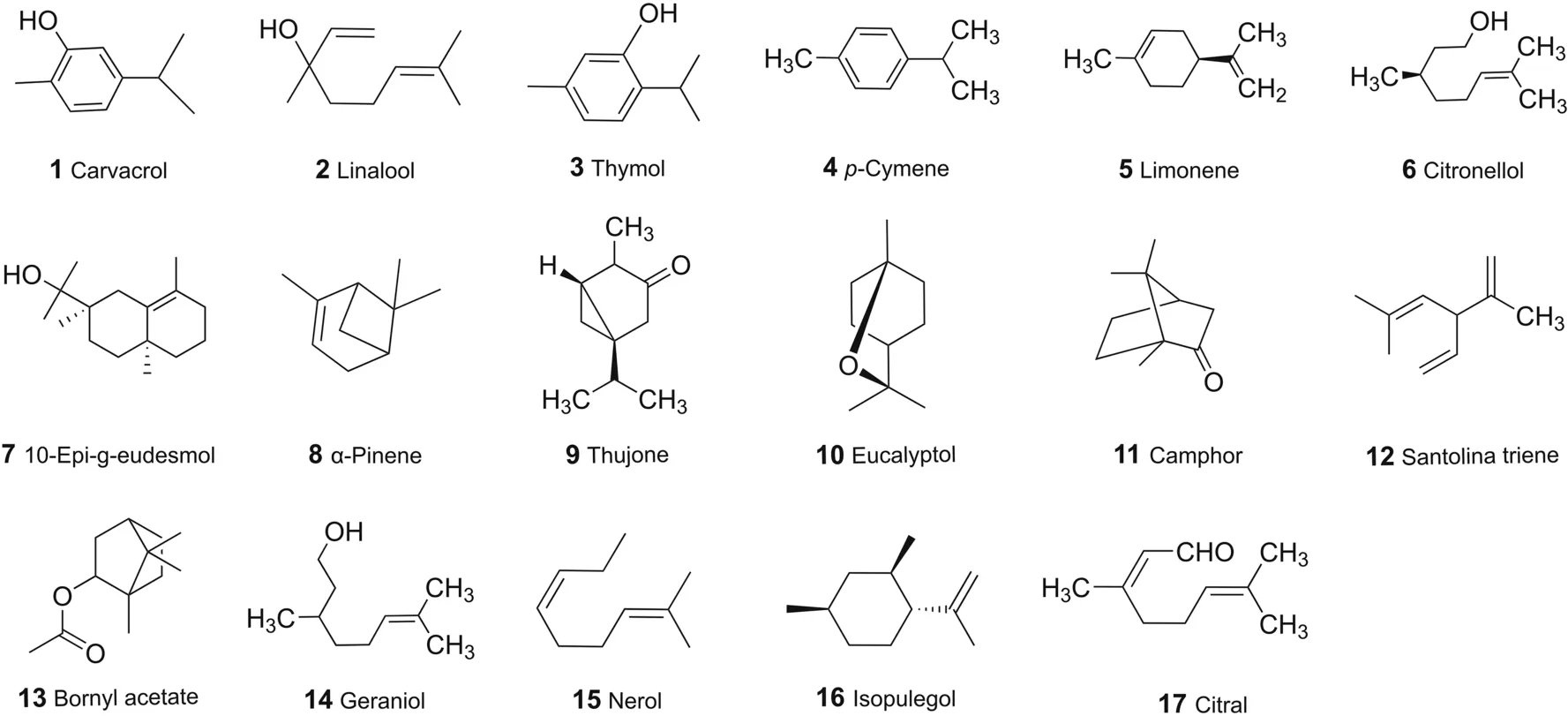
Fig.3.Structures of terpenoids identified in Moroccan medicinal plants possessing potent anti-inflammatory and analgesic activities.
6.Mechanisms of action of bioactive compounds isolated from Moroccan medicinal plants with anti-inflammatory effects
6.1.Terpenoids
6.1.1.Thymol
Thymol shows an anti-inflammatory effect in both in vitro and in vivo models(Table 3)[43-99].This compound inhibits certain enzymes involved in the inflammatory reaction,particularly elastase,COX-1,and COX-2[100,101].The inhibition of elastase is attributed to the hydrophobic property of thymol[100].In a proliferation assay,in vivo investigations revealed that thymol suppressed inducible lymphocyte proliferation[102].In carrageenaninduced paw edema,thymol significantly reduces edema.Furthermore,thymol decreases leukocyte influx into injured areas[103].In a model using high-fat-diet(HFD)-induced hyperlipidemia and atherosclerosis in rabbits,Yu et al.[50]revealed thymol significantly inhibited proinflammatory cytokines,especially interleukin-1β (IL-1β),IL-6,tumor necrosis factor α (TNF-α),and TNF-β.Additionally,thymol reduced the levels of TNF-α (40%)in doxorubicin(DOX)-induced cardiotoxicity in Swiss albino rats[56].In another study,thymol decreased the expressions of IL-1β,c-Fos,nuclear factor of activated T-cells(NFAT)-1,and NFAT-2 and significantly inhibited inducible phospho-SAPK/JNK and phospho-STAT3 levels[55].Recently,thymol was evaluated in a human peritoneal mesothelial cell line(HMRSV5)using a lipopolysaccharide (LPS)-induced inflammatory response[51].The results revealed a potent suppression of cytokine production,including TNF-α,IL-6,monocyte chemoattractant protein 1(MCP-1),and αsmooth muscle actin(α-SMA),in a dose-dependent manner.The mechanistic investigation revealed an inhibitory effect of toll-like receptor 4(TLR4)upregulation,as well as suppression of IKK,IκBα,and p65 phosphorylation[51].In dextran sulfate sodium(DSS)-induced experimental colitis,thymol reduces the expression of TNF-α,IL-1β,and IL-6 in the mouse colon[54].Furthermore,thymol demonstrates an inhibitory effect on the LPS-induced secretion of nitric oxide(NO),TNF-α,IL-1β,and IL-6 in macrophages,as well as suppresses NF-κB pathway activation[54].Thymol is capable of inducing membrane stabilization(84.11%)on assaying human red blood cell membrane stabilization[52].
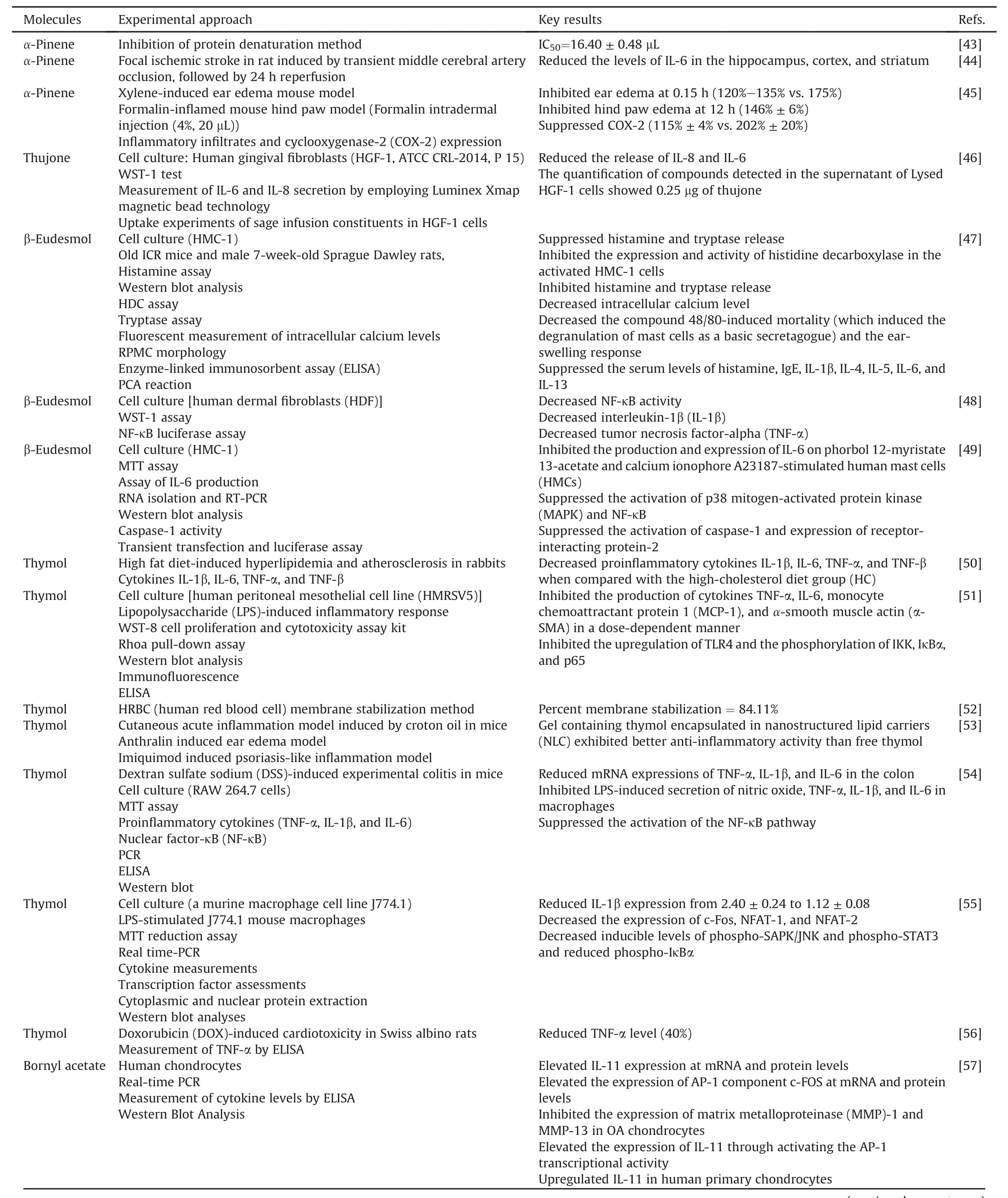
Table 3Anti-inflammatory effect of volatile compounds identified in Moroccan medicinal plants with anti-inflammatory properties.
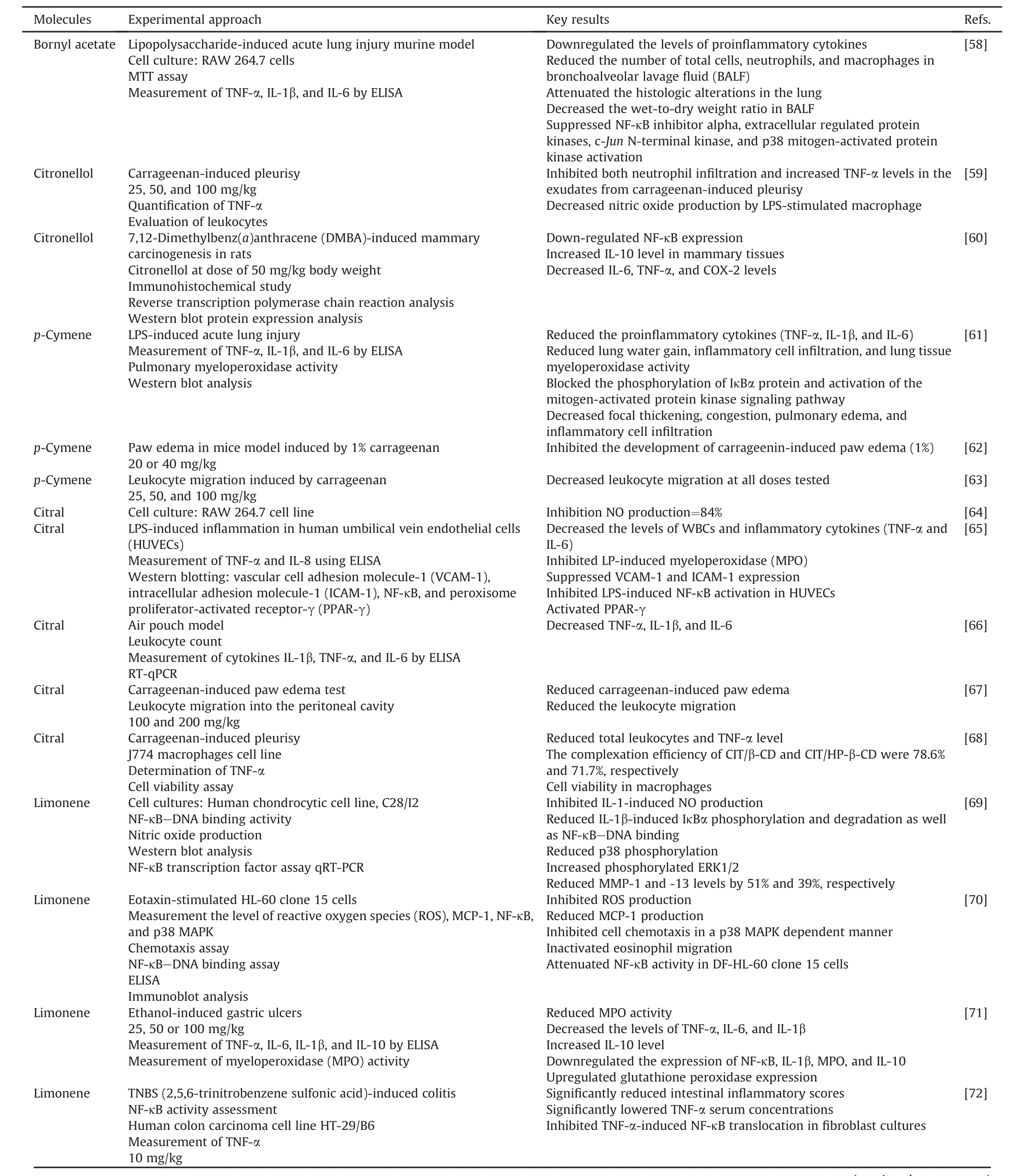
Table 3(continued)
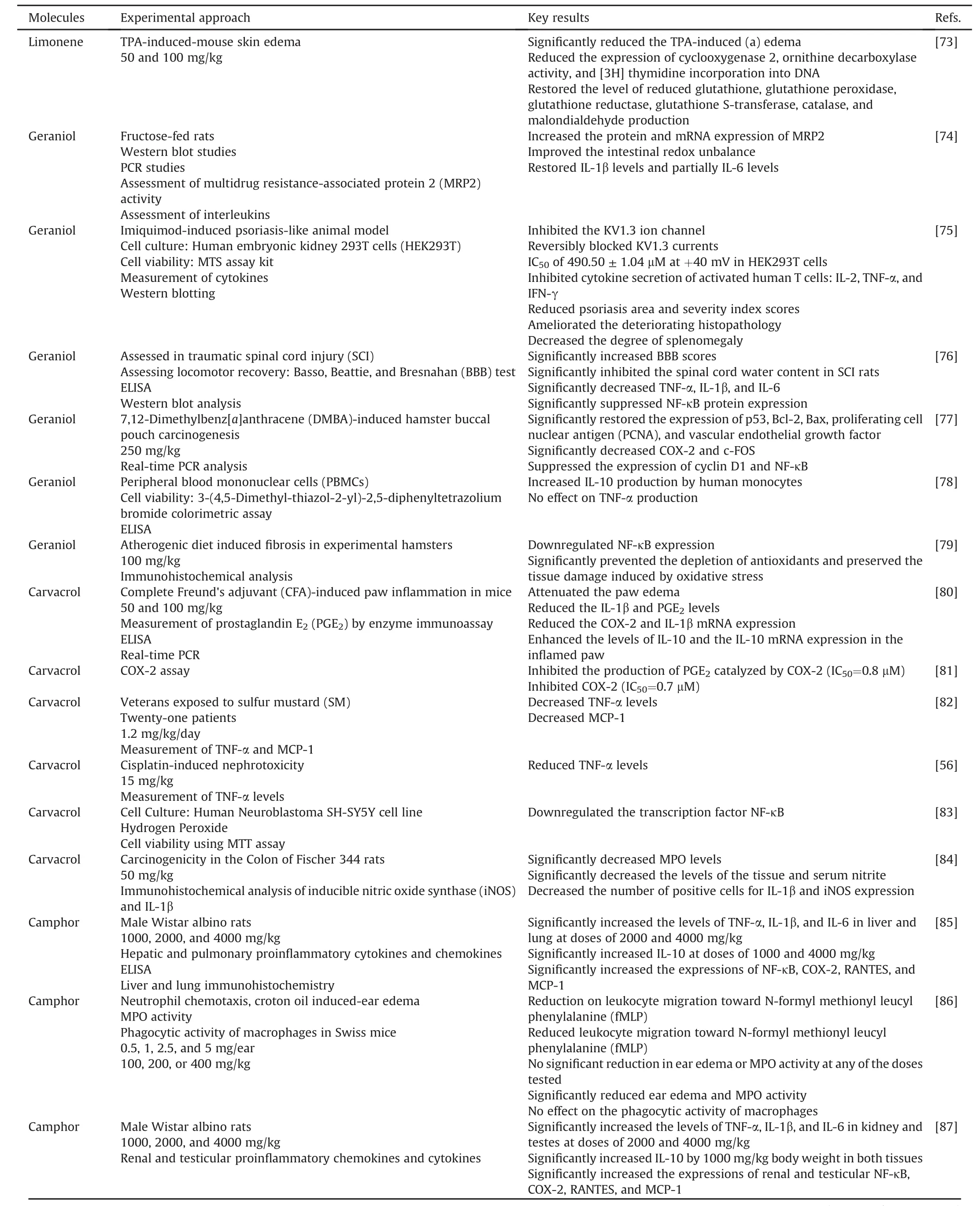
Table 3(continued)
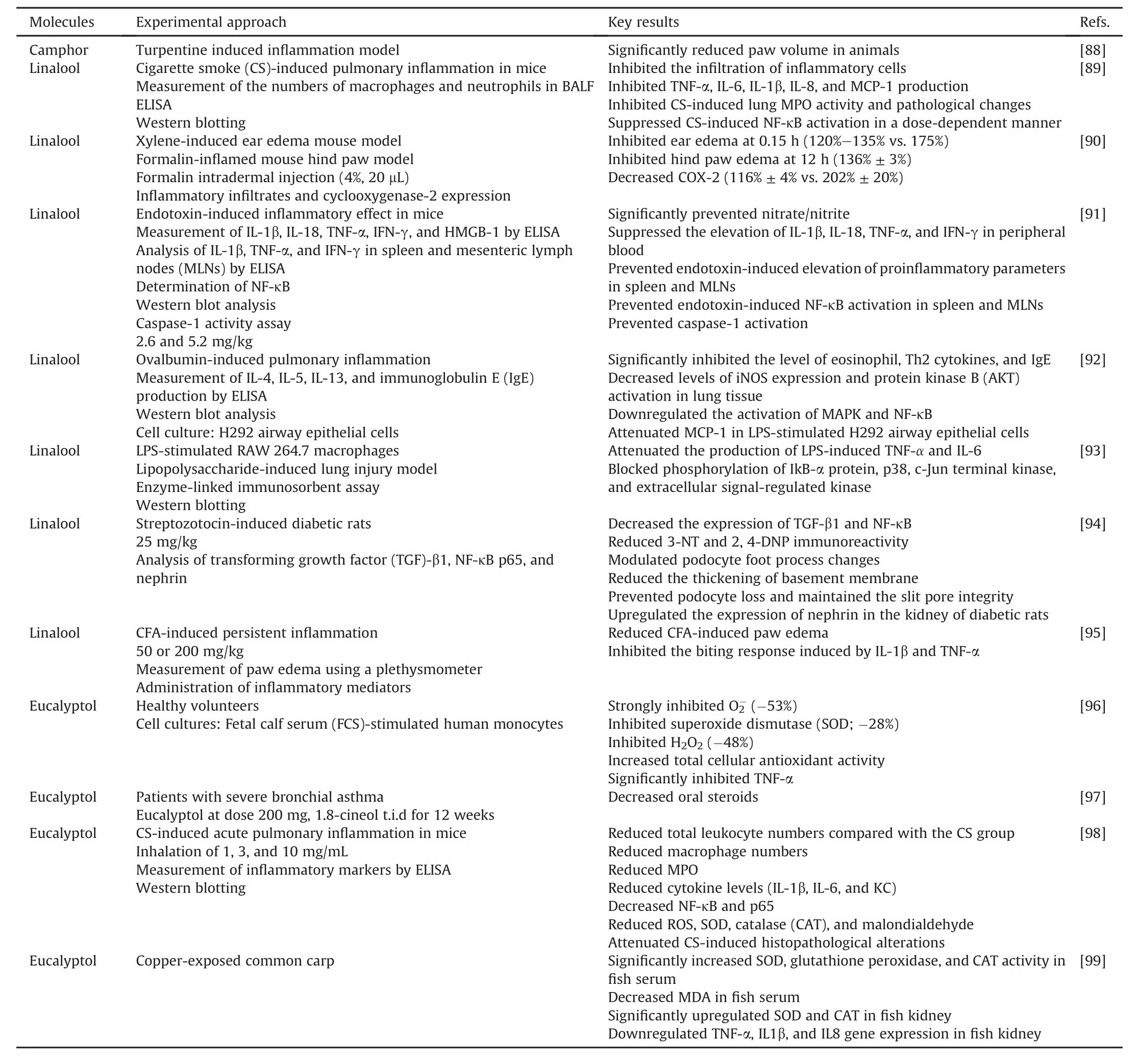
Table 3(continued)
6.1.2.Carvacrol
Carvacrol(2-methyl-5-[1-methylethyl]-phenol)exhibits several pharmacological activities,including anti-inflammatory effects(Table 3).According to Landa et al.[81],carvacrol inhibits the production of PGE2(an inflammatory mediator catalyzed by COX-2).The catalytic activity of COX-2 is also inhibited by carvacrol,and the authors suggested that this compound exhibits a non-selective inhibitory effect on COX-2,reducing PG production by inactivating the arachidonic acid metabolic pathway.In another study,the effect of carvacrol was investigated on transcriptional factors regulating COX-2 expression[104].Carvacrol inhibits peroxisome proliferatoractivated receptors(PPARs),which act as ligand-dependent transcription factors that regulate the transcription of COX-2.In this study,a cell-based transfection assay using bovine arterial endothelial cells was performed.Carvacrol suppresses COX-2 promoter activity by activating PPARα and PPARγ.Furthermore,carvacrol reduces the expression of LPS-induced COX-2 mRNA and protein levels,suggesting that the action of carvacrol on COX-2 is mediated via its agonistic effect on PPARγ[104].
6.1.3.β-Eudesmol
Reportedly,β-eudesmol is a potent anti-inflammatory agent[47-49].This phenolic monoterpene inhibits the production and expression of IL-6 in phorbol-12-myristate-13-acetate and calcium ionophore A23187-stimulated human mast cells(HMCs)(Table 3).The mechanistic investigation revealed that β-eudesmol suppressed the activation of p38 mitogen-activated protein kinase(MAPK)and NF-κB,as well as caspase-1,and the expression of receptor-interacting protein-2[49].In another in vitro and in vivo investigation,Han et al.[47]reported that β-eudesmol suppressed histamine and tryptase in activated HMC-1 cells.Furthermore,βeudesmol inhibited the expression and activity of histidine decarboxylase,decreased the level of histamine and tryptase released,and reduced the level of intracellular calcium[47].Kim[48]evaluated the anti-inflammatory effect of β-eudesmol in cell culture(human dermal fibroblasts)and revealed decreased NF-κB activity and reduced IL-1β and TNF-α levels[48].
6.1.4.Limonene
Yoon et al.[105]reported that limonene decreased the production of proinflammatory cytokines and inflammatory mediators in macrophages.This decrease was mediated by the inhibition of LPS-induced NO and PGE2,which decreased iNOS and COX-2 expression.In another in vitro study,limonene exhibited antiinflammatory effects by inhibiting specific signaling pathways that result in the inflammatory process in the leukemia HL-60 cell line,including reactive oxygen species(ROS),MCP-1,NF-κB,and p38 MAPK.Limonene suppressed the production of ROS at low concentrations.At higher concentrations,limonene attenuated the expression of p38 MAPK and decreased MCP-1 production[70].
6.1.5.Bornyl acetate
Tung et al.[106]reported that bornyl acetate showed potent antiinflammatory activity on macrophages.Additionally,bornyl acetate demonstrated significant anti-inflammatory and analgesic effects[107].It decreased the writhing reaction,pain,and suppressed ear swelling induced by dimethylbenzene,thus clarifying its antiinflammatory effect.Additional studies have evaluated the impact of bornyl acetate on several immune cells and cytokine secretion[108-110].Their results revealed that this monoterpene increased the number of CD4+T lymphocytes,while CD8+T lymphocytes were not increased.It also suppressed cytokines such as IFN-γ/IL-4[109].
6.1.6.α-Pinene
α-Pinene exhibits potent activity against the inflammatory process and neuropathic pain[110].Reportedly,α-pinene exhibits an anti-ischemic activity on neuronal cells by reducing cerebral ischemic injury[111].This compound prevents neuronal cell death by decreasing ROS generation induced by oxygen-glucose deprivation.Following exposure to T-α-pinene,the expression of proinflammatory cytokines levels in the ischemic brain is reduced,whereas glial cells are hyper-stimulated[111].In an in vivo model of xylene-induced ear edema using a formalin-inflamed mouse hind paw,Li et al.[45]observed that α-pinene inhibited ear edema at 0.15 h(120%-135%vs.175%),paw edema at 12 h(146%±6%)and decreased COX-2 expression(115%±74%vs.202%±20%).More recently,Khoshnazar et al.[44]revealed that α-pinene reduced IL-6 levels in the hippocampus,cortex,and striatum.
6.1.7.1,8-Cineole
Using the trinitrobenzene sulfonic acid(TNBS)-induced colitis model in rats,Chen et al.[112]showed that 1,8-cineole possessed a crucial anti-inflammatory effect.This activity was related to the capacity of 1,8-cineole to decrease myeloperoxidase(a biomarker of neutrophilic infiltration)[112].Inhibition of myeloperoxidaseproduction indicates that this compound could play an important role in preventing gastrointestinal inflammation and ulceration[113].
6.1.8.Geraniol
The anti-inflammatory activity of geraniol has been previously investigated[114].This bioactive compound exhibits a dosedependent,anti-inflammatory effect on lymphocyte proliferation in vitro.An in vivo study using a cardiac allograft model showed that geraniol prolonged graft survival[114].Mevalonate kinase deficiency is reportedly responsible for the recruitment of inflammatory cells.The inhibition of the mevalonate pathway can reduce intermediate metabolites such as geranylgeranyl-pyrophosphate(GGPP),which is responsible for IL-1β production in monocytes.Both in vitro and in vivo,geraniol is able to reduce the levels of inflammatory markers.Therefore,this molecule can provide a crucial alternative to treat inflammation associated with mevalonate kinase deficiency[115].
6.1.9.Linalool
Linalool is another monoterpene known to exhibit antiinflammatory effects.This compound exhibits a significant effect on chronic inflammatory hypersensitivity induced by complete Freund's adjuvant.In adult female Swiss mice,an i.p.injection of linalool at 50 and 200 mg/kg reduces hypersensitivity and paw edema[95].Linalool also shows anti-inflammatory activity in the carrageenan-induced edema model in rats[116].
6.1.10.Nerol and citral
Using an animal model,Gonz′alez-Ramírez et al.[117]revealed that nerol exhibited anti-inflammatory and antinociceptive(30-300 mg/kg p.o.)effects.Nerol suppressed several pathological alterations induced by oxazolone(OXA)-induced colitis.These effects were associated with the inhibited expressions of several inflammatory mediators,such as IL-13 and TNF-α.Citral exhibits potent anti-inflammatory effects by activating peripheral neutrophils and inducing their adherence[118].
6.2.Phenolic acids
6.2.1.Gallic acid
Gallic acid is a crucial phenolic compound present in several Moroccan medicinal plants with anti-inflammatory effects[119,120].Numerous in vitro investigations were undertaken to assess the anti-inflammatory effects of gallic acid using cellular models(Table 4)[47,119-152].
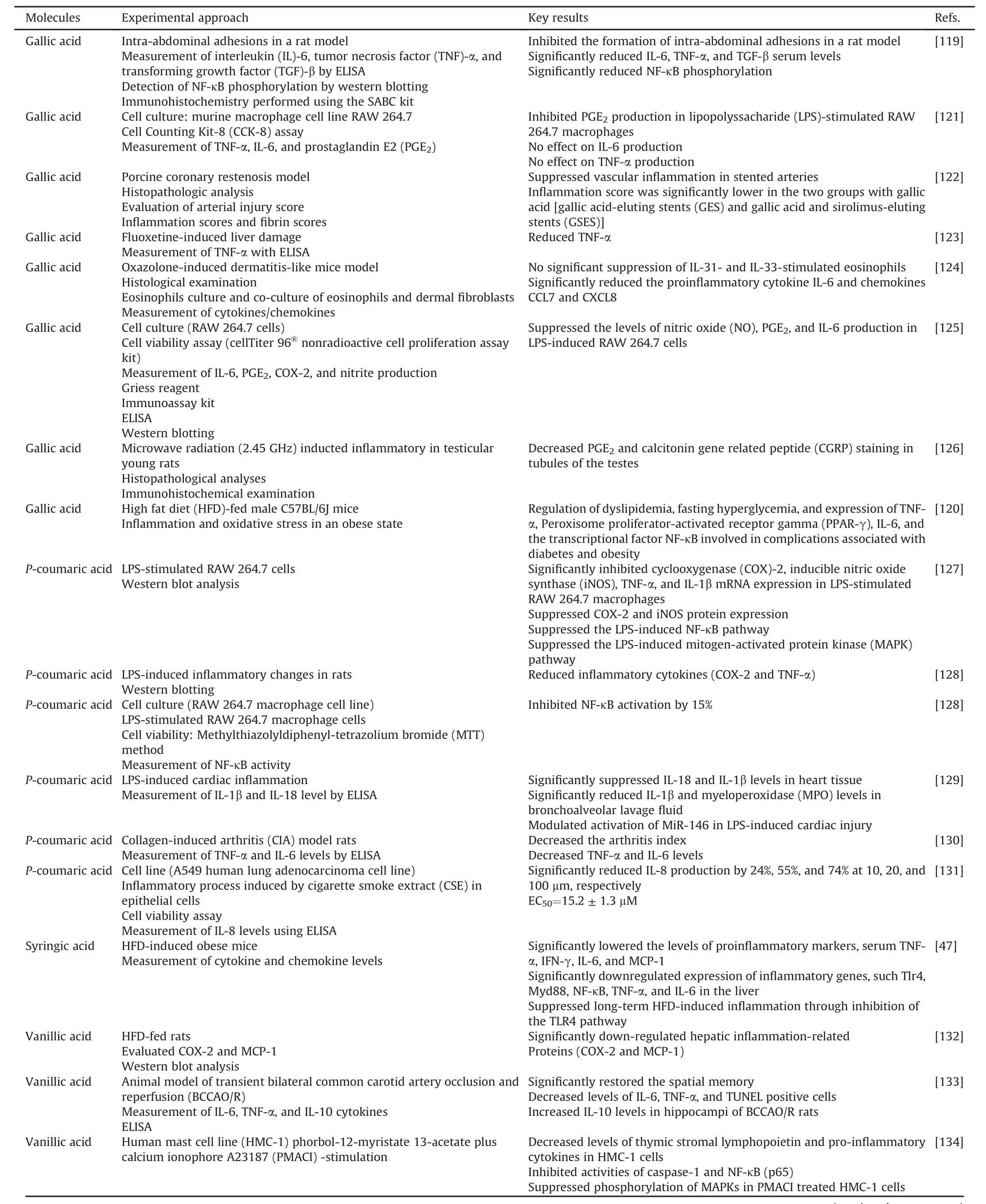
Table 4Anti-inflammatory effect of phenolic compounds identified in Moroccan medicinal plants with anti-inflammatory properties.

Table 4(continued)

Table 4(continued)
Using the LPS-stimulated murine macrophage cell line(RAW 264.7),gallic acid inhibited PGE2,with no effects on IL-6 and TNF-α production[121].By employing the same cellular model,gallic acid revealed a potent anti-inflammatory impact by suppressing NO,PGE2,and IL-6 expression in LPS-induced RAW 264.7 cells[125].Additionally,gallic acid shows a potent anti-inflammatory effect in animal models.This compound reportedly decreased the production of PGE2and calcitonin in testicular tissues of young rats[126].Furthermore,gallic acid significantly reduces the proinflammatory cytokine IL-6 and chemokines CCL7 and CXCL8 in an in vivo model of OXA-induced dermatitis[124].This compound reduces the inflammatory response related to oxidative stress in obese C57BL/6J mice fed an HFD[120].The results revealed that gallic acid regulated dyslipidemia,fasting hyperglycemia,and the expression levels of TNF-α,PPAR-γ,IL-6,and transcriptional factor NF-κB[120].Wei et al.[119]observed similar results in an in vivo model of intraabdominal adhesions.Gallic acid suppresses inflammation owing to its capacity to inhibit the formation of intra-abdominal adhesions in a rat model,reduces IL-6,TNF-α,and TGF-β expression,and represses the phosphorylation of transcriptional factor NF-κB[119].
6.2.2.Caffeic acid
Caffeic acid is a phenolic acid primarily found in various Moroccan medicinal plants with anti-inflammatory effects(Table 4).In an in vivo investigation using animal models,this compound exhibits a marked anti-inflammatory effect,as demonstrated by various bioassays[146,147,149-151].In the carrageenaninduced edema model,caffeic acid inhibits NO and PGE2production[148].It also decreases TNF-α,iNOS,and COX-2 expressions by downregulating transcriptional NF-κB[148].In another in vitro study using LPS-induced NO production in RAW 264.7 macrophages,caffeic acid inhibits LPS-induced iNOS expression in RAW 264.7 macrophages and inhibits carrageenan-induced paw edema[149].Recently,Schr¨oter et al.[150]revealed that caffeic acid induced a significant decrease in iNOS,TNF-α,and IL-6 expression.This action is associated with a decline in the translocation of NF-κB/rel-like containing protein 65 into the nucleus[150].
6.2.3.Ferulic acid
Ferulic acid reveals an anti-inflammatory effect in various in vitro and in vivo studies(Table 4).This compound presents potent anti-inflammatory activity(in vitro)in rat vascular smooth muscle cells(VSMCs)[145].Ferulic acid decreases IL-6,IL-1β,and TNF-αlevels and inhibits iNOS gene expression in H2O2-induced VSMCs,as well as H2O2-induced iNOS mRNA expression.This inhibition involves a decrease in p22phox,p47phox,and gp91phox mRNA expression,with reduced gp91phox,p47phox,and NOX4 levels in H2O2-induced VSMCs[145].Doss et al.[143]evaluated the anti-inflammatory activity of ferulic acid against monosodium urate crystal-induced inflammation in rats.The results revealed a decrease in paw edema,with levels of articular elastase and lysosomal enzymes significantly reduced.More importantly,ferulic acid suppresses TNF-α,IL-1β,NLRP3,and caspase-1 expressions by inhibiting the transcriptional factor NF-κB p65.In another experimental model,mice were exposed to unpredictable chronic mild stress,and this molecule decreased several neuro-inflammatory factors such as IL-1β and TNF-α in the prefrontal cortex[142].
6.2.4.Sinapic acid
In an in vitro study using the BEAS-2B cell line,sinapic acid inhibits NF-κB activation and decreases IL-6 and IL-8 expression[138].Furthermore,this acid decreases TNF-α in TNBS-induced colonic inflammation in mice[139].In an in vitro cellular model employing rat chondrocytes,sinapic acid revealed an antiinflammatory effect mediated via MAPK pathway with inhibiting IL-1β-induced NO,and PGE2expression,and a decrease in iNOS and COX-2 production[140].In an animal model of gentamicin-induced nephrotoxicity,sinapic acid inhibited gentamicin-induced expression of TNF-α and IL-6,while suppressing the expression of NF-κB and NF-κB-DNA binding activity[141].
6.3.Flavonoids
6.3.1.Quercetin
Several reports have evaluated the anti-inflammatory properties of quercetin[153,154].Both COX-1 and 12-LOX are involved in mediating the inflammatory response.Inhibiting these enzymes or reducing their activities is a crucial step in suppressing inflammation.Lesjak et al.[155]revealed that quercetin inhibited the activity of both enzymes in a dose-dependent manner.The expression of these enzymes is often associated with an increase of TNF-α.Quercetin reduced TNF-α expression in a mouse model of endotoxemia[156].In a cellular model,this flavonoid inhibits the expression of several inflammatory mediators,including NO,IL-6,MCP-1,IP-10,regulated upon activation,normal T cell expressed,and secreted (RANTES), granulocyte/macrophage colonystimulating factor(GM-CSF),granulocyte colony-stimulating factor(G-CSF),TNF-α,leukemia inhibitory factor(LIF),lipopoly saccharide-induced CXC chemokine(LIX),and vascular endothelial growth factor(VEGF).This inhibition is mediated by the repression of signal transducer and activator of transcription 1(STAT1)and STAT3,which regulates the transcriptional activity of these mediators[154].In an in vivo investigation,quercetin suppresses inflammation in mice[153].Additionally,it decreases skin inflammation by reducing irritation,edema,and leukocyte accumulation.In mice,quercetin triggers tissue regeneration by stimulating new tighter collagen fibers in tetradecanoylphorbol acetate(TPA)-induced skin inflammation[153].Moreover,in HFD-induced adipose tissue macrophage infiltration and inflammation in mice,quercetin suppresses the levels of proinflammatory cytokines TNF-α,IL-6,and MCP-1 in the epicardial adipose tissue,enhancing AMPK1 and SIRT1 activity in adipose tissues.Quercetin regulates bone marrow-derived macrophage polarization and inflammation through the AMPK1/SIRT1 pathway[157].In another experimental model using rat adjuvant arthritis,quercetin reduces IL-1β,creactive protein(CRP),and MCP-1 levels[158].These effects are associated with its potential to restore plasma antioxidant capacity.Molecular analysis of the anti-inflammatory effect revealed that quercetin inhibited the enzymatic activity of proinflammatory 12/15-LOX in lung and liver tissues,as well as their expression.These actions are associated with a decrease in transcriptional factor NF-κB activity[158].
6.3.2.Epicatechin
Epicatechin is another flavonoid compound that shows an antiinflammatory effect both in vitro and in vivo.Several studies revealed that epicatechin regulated the inflammatory process in the LPS-induced production of proinflammatory mediators in RAW 264.7 cells[159-161].In a study reported by Wang and Cao[159],epicatechin inhibits the production of proinflammatory mediators,such as NO,PGE2,TNF-α,and IL-6,in LPS-induced RAW 264.7 macrophages.This compound reduces nitrite,PGE2,and other proinflammatory cytokines(IL-1β,IL-6,and TNF-α)in RAW 264.7 cells[160].This inhibition is associated with several molecular mechanisms,especially the downregulation of translocated levels of p50 and p65 and IKK α/β phosphorylation levels in RAW 264.7 cells,resulting in NF-κB activation[160].Using the same approach,Chiou et al.[161]showed that epicatechin attenuated ROS levels and suppressed LPS-induced iNOS and COX-2 expression.This flavonoid interferes with the cross-talk between NF-κB and nuclear factor erythroid-derived factor 2-related factor 2-antioxidant response element(Nrf2-ARE)signaling,therefore activating Nrf2 and suppressing NF-κB,which represses proinflammatory mediators[161].In the carrageenan-induced paw edema model,epicatechin suppresses induced inflammation and exhibits an anti-inflammatory effect at 100 mg/kg(59%)[162].Furthermore,quercetin suppresses the writhing response in mice and reduces the expression levels of PGE2,TNF-α,IL-1β,and IL-6[163].In another investigation employing diet-induced human-CRP and NF-κB in vivo,epicatechin quenches the formation of the liver-derived pro-atherogenic factors,serum amyloid A and human-CRP,and inhibits diet-inducs NF-κB activity[164].In obese mice(after HFD consumption-induced inflammation in C57BL/6J mice),epicatechin prevents HFD-induced increases in TNF-αand MCP-1 in the visceral adipose tissue.Quercetin inhibits palmitateinduced increase in IL-6 and TNF-α secretion and decreases adiponectin secretion [165].Epicatechin alleviates HFD-induced oxidative and endoplasmic reticulum stress by inhibiting NADPH oxidases(NOX-4 and NOX-2)in the visceral fat of HFD-fed mice[165].
6.4.Alkaloids
Alkaloids have been detected in some Moroccan medicinal plants that possess anti-inflammatory and analgesic activities.One example is D.staphysagria containing diterpenoid alkaloids as the main active compounds[27].Alkaloids have shown an antiinflammatory effect involving several mechanisms of action[42,166],including the inhibition of inflammatory mediators such as interferon-γ,TNF-α,IL-12,and also via a specific inhibitory effect on certain enzymes involved in the inflammatory process such as LOX and COX[166].
7.Insights into the analgesic mechanism of bioactive compounds isolated from Moroccan medicinal plants
7.1.Volatile compounds
Various terpenoids have been identified in analgesic Moroccan medicinal plants,including α-pinene,thymol,limonene,linalool,isopulegol,carvacrol,camphor,phenol-camphor,and bornyl acetate(Table 5)[88,167-180].Bornyl acetate was assessed for its analgesic effect using in vivo models[171,172].Using hot plate and writhing reaction assays,Wu et al.[171]reported that bornyl acetate reduced the writhing reaction induced by glacial acetic acid and reduces the pain caused by the hot plate.
Bornyl acetate was also evaluated using the tail clip and formalin models of pain,inhibiting phases I and II pain in formalin-induced pain model[171].In another study using the same experimental methods,bornyl acetate exhibits a marked inhibitory effect on phases I and II pain in the formalin-induced pain model,with a pronounced analgesic effect afforded against pain induced by the tail clipping model[171].Conversely,carvacrol shows an analgesic effect against formalin-,capsaicin-,and glutamate-induced orofacial nociception in mice administered at 25,50,and 100 mg/kg i.p.Carvacrol reduces the nociceptive face-rubbing behavior and produces a pronounced antinociceptive effect at all investigated doses[170].The analgesic effect of isopulegol was evaluated using acetic acid-induced writhing and hot plate tests[169].The administration of isopulegol at 0.5,1,5,10 mg/kg exhibits significant analgesic activity as demonstrated by the percentage of pain inhibition(7.4%±1.3%)at 0.5 mg/kg and the percentage of pain protection(20.3%±2.2%)(Table 5).Linalool is another monoterpene detected in some Moroccan medicinal plants,which was evaluated for its anti-inflammatory effects using the formalin-inflamed mouse hind paw model,thermal nociceptive threshold,and plantar analgesia measured at different time points[167].The results showed that this volatile compound exhibited superior and faster lowering of swelling and pain.In contrast,the anti-inflammatory effect of limonene was evaluated using the pain-related behavior model by administering intraplantar H2O2[168].Limonene reduces the total number of nociceptive behaviors when compared with mice treated with the vehicle and suppresses TRPA1-mediated oxidative stress-induced nociception[168].
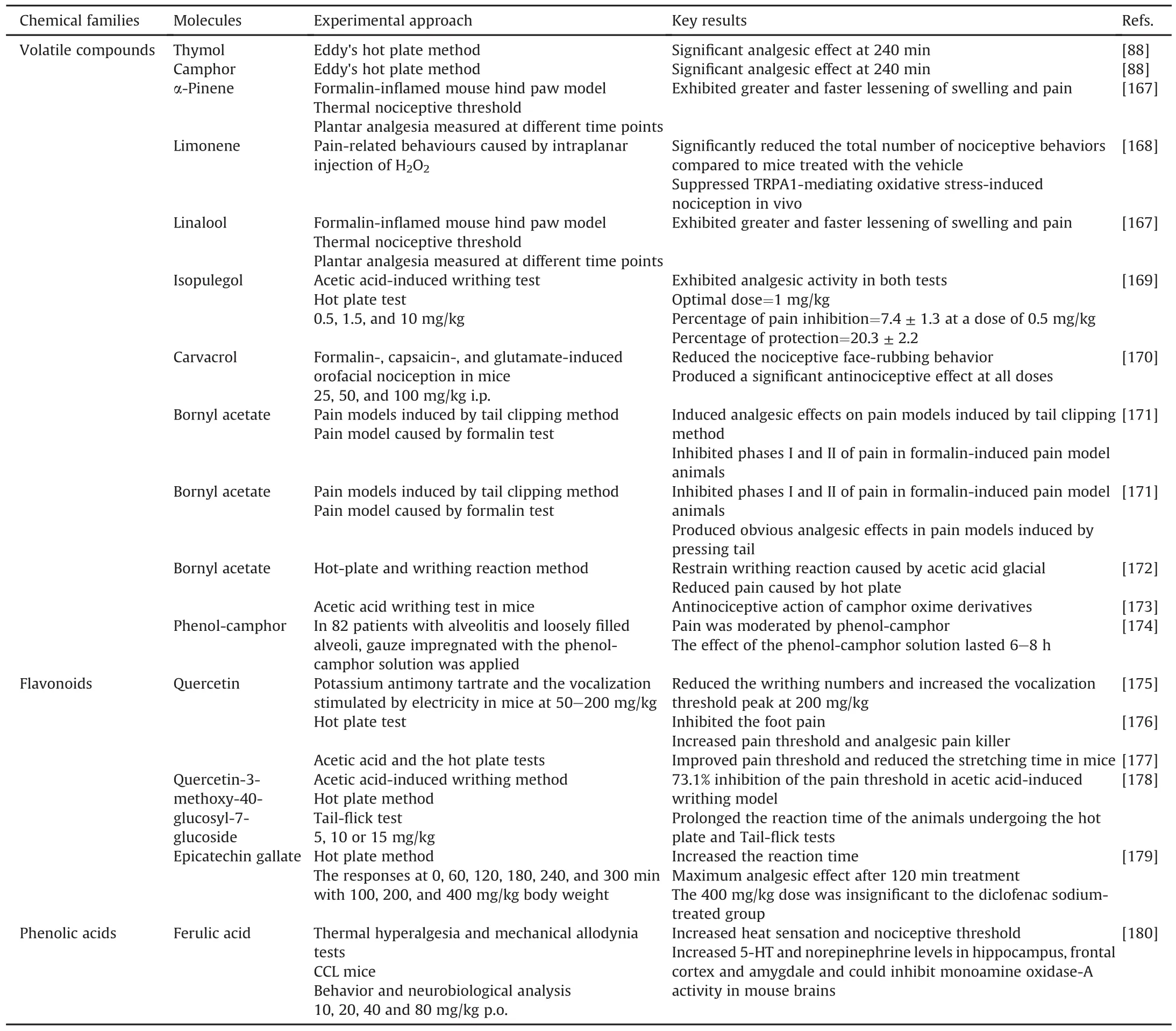
Table 5Analgesic mechanism insights of bioactive compounds isolated from Moroccan medicinal plants with analgesic effects.
7.2.Flavonoids
Some flavonoids identified in Moroccan medicinal plants,such as quercetin,quercetin-3-methoxy-40-glucosyl-7-glucoside,and epicatechin gallate,have shown potent analgesic activities in vivo[175-179].Quercetin was tested against potassium antimony tartrate and electrically stimulated vocalization in mice(50-200 mg/kg)(Table 5).It reduces the writhing numbers and raises the vocalization threshold peak at 200 mg/kg[175].In another study,quercetin inhibits foot pain and increases the pain threshold,demonstrating analgesic effects[176].Quercetin improves the pain threshold and reduces the stretching time in mice assessed using acetic acid and the hot plate tests[177].Quercetin-3-methoxy-40-glucosyl-7-glucoside was evaluated for its analgesic effect by employing acetic acid-induced writhing,hot plate,and tail-flick models[178].At doses of 5,10,or 15 mg/kg,quercetin inhibits the pain threshold(73.1%)in the acetic acid-inducedwrithing model.Furthermore,it prolongs the reaction time of the animals during the hot plate and tail-flick tests[178].Epicatechin gallate suppresses inflammation induced by the hot plate method.The administration of epicatechin gallate at 100,200,and 400 mg/kg body weight increases reaction time,showing a maximum analgesic effect after 120 min of treatment[179].
7.3.Phenolic acids
Only one molecule belonging to phenolic acids was isolated from Moroccan plants and investigated for potential analgesic effects(Table 5)[180].Using thermal hyperalgesia and mechanical allodynia tests,as well as behavioral and neurobiological analysis in mice,ferulic acid,at 10,20,40,and 80 mg/kg p.o.,increases the mechanical allodynia and nociceptive threshold.Ferulic acid increases 5-HT and norepinephrine levels in the hippocampus,frontal cortex,and amygdala and decreases monoamine oxidase(MAO)-A activity in mouse brains[180].
8.Clinical evidence
The clinical evaluation of natural antidiabetic substances is a necessary step to discover novel antidiabetic drug leads.The bioactive molecules identified in Moroccan plants with inflammatory properties have been evaluated in humans.Researchers assessed these substances in patients or healthy individuals,with some compounds currently under investigation in different clinical trials at different phases.The results reported in previous studies are presented in Table 6[72,181-193],which summarizes the name of the molecule,the experimental approach,the clinical phase,and major results.Several molecules,especially those belonging to the flavonoid class of compounds,have been evaluated.
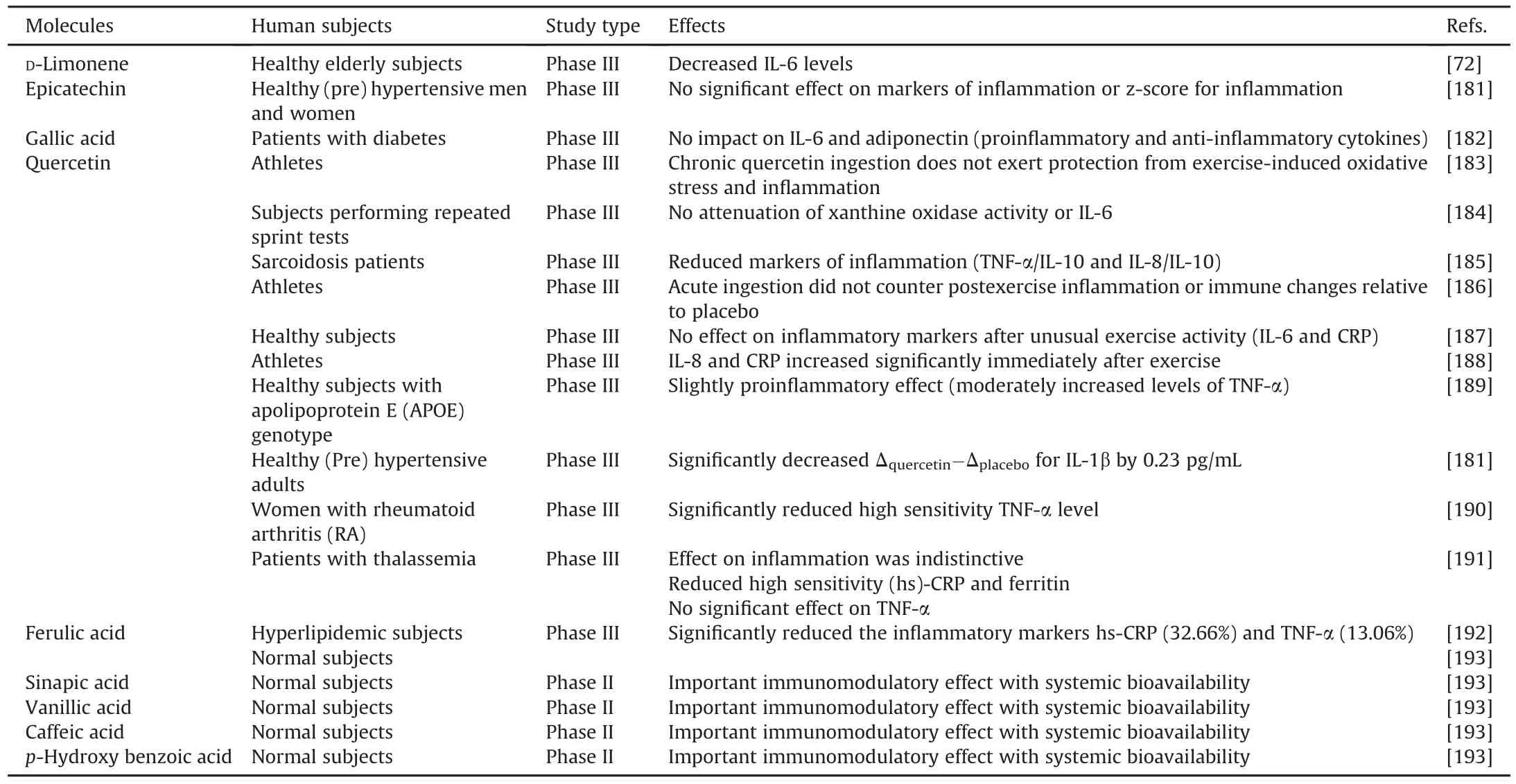
Table 6Clinical evidence of anti-inflammatory activity of bioactive compounds in Moroccan medicinal plants with anti-inflammatory effects.
In clinical investigations,quercetin is the most frequently investigated molecule for its anti-inflammatory properties.This molecule has been assessed in several clinical trials and is undergoing phase III trials.McAnulty et al.[183]showed that quercetin ingestion does not exert protection from exercise-induced oxidative stress and inflammation.However,increasing the quercetin plasma concentration inhibited the generation of inflammatory mediators such as cytokines and chemokines.Moreover,in the field of athletics,Konrad et al.[186]revealed that this molecule significantly decreased the expression of numerous inflammatory factors and mediators.Indeed,quercetin decreases CRP levels,GM-CSF,and interleukins(IL-10,IL-1b,IL-2,IL-6,and IL-8).However,acute ingestion of quercetin did not exhibited inflammatory or immune changes relative to placebo.In another report[188],quercetin significantly increases the level of IL-8 and CRP following exercise.In another work,results showed that physical activity resulted in significant increases in CRP,GM-CSF,IL-10,IL-1β,IL-2,IL-6,IL-8,and TNF-α.However,acute ingestion of quercetin 15 min before strenuous exercise caused a sharp increase in plasma quercetin levels,but did not counteract either the immune response or postexercise inflammation compared to the placebo effect[186].Dower et al.[181]investigated the effect of quercetin supplementation on biomarkers of inflammation in(pre)hypertensive adults.Accordingly,quercetin significantly reduces the expression of IL-1β(by 0.23 mg/mL),in a placebo-controlled trial.These results corroborate those reported by Javadi et al.[190],who revealed a significant decrease in the level of highly sensitive TNF-α in women with rheumatoid arthritis.Furthermore,Sajadi Hezaveh et al.[191]recently demonstrated that quercetin affords a protective effect against inflammation in patients with thalassemia.However,additional studies failed to detect any impact on inflammatory markers[184,187]in healthy subjects.In another study performed in 2013 on healthy subjects with the apolipoprotein E genotype,quercetin shows a moderately increased level of TNF-α[189].Regarding epicatechin,a study by Dower et al.[181]clinically evaluated the anti-inflammatory potential of epicatechin supplementation in healthy women and men with hypertension.The results showed no significant effect on inflammatory markers or the z-score of inflammation.Ferk et al.[182]evaluated the antiinflammatory action of gallic acid in patients with diabetes.The results revealed that gallic acid consumption(15 mg/day)for seven days significantly reduced CRP(by 39%)but had no effect on IL-6 and adiponectin.In a clinical study by Bumrungpert et al.[192],patients with hyperlipidemia received ferulic acid supplementation and showed an attenuation of the inflammatory marker TNF-α(13.06%)and hs-CRP(32.66%).
9.Conclusions and perspectives
In the present review,we revealed that Moroccan medicinal plants possess anti-inflammatory and analgesic effects,with significant heterogeneity depending on the medicinal species,the type of extracts and/or essential oils,and assay methods employed.The anti-inflammatory and analgesic effects appear to be associated with the medicinal plant's secondary metabolites,such as flavonoids,alkaloids,and terpenes.These bioactive compounds have presentedan anti-inflammatory effect through numerous targeted pathways,particularly by inhibiting mediators involved in inflammatory processes.Other mechanisms of action were discussed,including the deregulation of gene expression of some transcriptional factors promoting inflammation-related signaling pathways.These data suggest that Moroccan medicinal plants are rich in bioactive molecules,which could be a promising resource for identifying new antiinflammatory and analgesic drugs.However,further investigations exploring additional Moroccan medicinal plants for their antiinflammatory and analgesic effects are warranted.Furthermore,the identification and isolation of different bioactive compounds from these medicinal species should be undertaken.Finally,in vitro and in vivo molecular investigations of these substances,as well as their clinical validation,will undoubtedly contribute to uncovering novel drugs from Moroccan medicinal plants possessing antiinflammatory and analgesic properties.
CRediT author statement
Abdelhakim Bouyahya:Conceptualization,Methodology,Data curation,Writing-Original draft preparation,Supervision;Fatima-Ezzahrae Guaouguaou,Nasreddine El Omari,Naoual El Menyiy:Visualization,Investigation,Writing and Editing;Abdelaali Balahbib:Methodology,Software;Mohamed El-Shazly:Investigation,Reviewing and Editing;Youssef Bakri:Supervision,Writing-Reviewing and Editing.
Declaration of competing interest
The authors declare that there are no conflicts of interest.
Acknowledgments
We thank the Centre National pour la Recherche Scientifique et Technique(CNRST)and l’Agence Nationale des Plantes M′edicinales et Aromatiques(ANPMA)for supporitng this study(Grant No.:PMA2019/1).
Appendix A.Supplementary data
Supplementary data to this article can be found online at https://doi.org/10.1016/j.jpha.2021.07.004.
杂志排行
Journal of Pharmaceutical Analysis的其它文章
- Screening strategies for quorum sensing inhibitors in combating bacterial infections
- Capillary electrophoresis methods for impurity profiling of drugs:A review of the past decade
- Antiviral,immunomodulatory,and anticoagulant effects of quercetin and its derivatives:Potential role in prevention and management of COVID-19
- Assessment of the binding interactions of SARS-CoV-2 spike glycoprotein variants
- Identifying the molecular basis of Jinhong tablets against chronic superficial gastritis via chemical profile identification and symptomguided network pharmacology analysis
- MTBSTFA derivatization-LC-MS/MS approach for the quantitative analysis of endogenous nucleotides in human colorectal carcinoma cells
